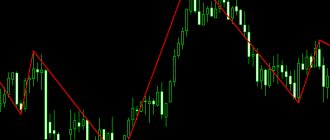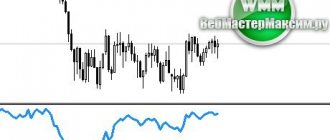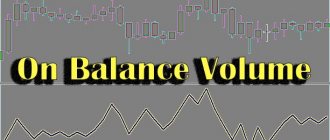Short review
Despite its name, CCI can be used in any market, not just commodities.
Overbought or oversold levels are not recorded, since the indicator is not tied. Therefore, traders look to past indicator readings to understand where the price turned. For one stock, it can turn around +200 and -150. Meanwhile, another commodity could turn around +325 and -350. Zoom out on the chart to see multiple price turning points and CCI values at that time.
There are also divergences - when the price moves in the opposite direction of the indicator. If the price is rising and the CCI is falling, this may indicate a weak trend. Although divergence is a bad trading signal because it can last a long time and does not always result in a price reversal, it can be useful in at least alerting a trader to the possibility of a reversal. Thus, they may tighten stop loss levels or delay opening new trades in the direction of the price trend.
The essence and features of CCI
The CCI indicator shows the deviation of the current price from the moving average. The moving average period is set by the trader himself. The stronger the price deviation in the short term from its average value, the higher (in the case of an uptrend) or lower (in the case of a downward trend) the oscillator line will move away from the zero mark. Most of the time, the indicator line fluctuates within the range formed by the +100 and -100 levels. When the line leaves this corridor, a signal appears that the asset is overbought or oversold. This is the basic Commodity Channel Index signal.
RegistrationDemo account
Unlike the RSI or Stochastic Oscillator, the CCI is not limited to the +100 and -100 levels. The Trading Channel Index line can drop to the level of -200 or to the level of -300 - this will only indicate that the downward trend is very strong and the market is in a state of deep oversold.
CCI indicator in practice
Like almost all oscillators, the CCI primarily indicates overbought or oversold conditions. When the CCI reaches a level above +100 (overbought) or below -100 (oversold) and moves back into the neutral zone (between +100 and -100), a signal is given to enter the market.
In this case we used a CCI of 50 periods. It must be remembered that overbought and oversold conditions should only be used in the direction of the trend. For example, we can use EMA to determine the trend if the market is in an uptrend. Overbought and oversold signals are triggered when the market returns to neutral territory (between -100 and +100 in the CCI).
The indicator can also show extreme price levels. As mentioned earlier, the CCI remains in neutral territory 80% of the time, so possible breakouts of these levels could indicate a strong price move in the same direction. A move above +100 is a buy signal, and a move below -100 is a sell signal.
We received about three signals on this chart. Two of them are for opening long positions, and one is for opening a short position.
When price makes new highs and the CCI indicator fails to do the same, divergence occurs. Divergence shows that although the trend is still the same, it is not as strong as before. Therefore, a potential price reversal is possible in the near future.
In the chart above, the CCI indicator fails to make a new high similar to the one made by the market, indicating a possible pullback, price reversal, or consolidation.
CCI is used for a breakout of a trend line. When the indicator forms two or more consecutive peaks or troughs, they can be connected to form a trend line. If the indicator reading breaks such a trend line, this signals the appearance of an entry point in the direction of the breakout.
The chart above clearly shows a breakout of the trend line.
We can also combine indicator readings.
When trading extreme CCI levels, it is also recommended to trade only those signals that are directed in the direction of the prevailing trend. Each triangle indicates a long or short signal. The rule is to only use signals in the direction of the trend.
Formula for constructing the indicator
The CCI indicator is constructed using the following formula: CCI = (0.015*Standard deviation) / (Typical price - SMA)
In this formula, “Typical price” means the arithmetic average of the minimum, maximum and close of any candle.
SMA is a simple moving average that is built using typical prices within a given period. 0.015 is a constant determined experimentally.
Standard deviation is a simple moving average, built not by typical prices, but by value (Typical price - SMA). That is, first you need to subtract the value of the simple moving average from the typical price, and then again average the resulting value using the SMA formula.
The period for all moving averages is the same.
Configuring and installing the CCI indicator
Commodity Channel Index is installed in the same way as other indicators. There are two installation paths:
- In the main menu of the terminal, you need to select “Insert” – “Indicators”, and then in the “Oscillators” category find “Commodity Channel Index”.
- On the top toolbar, click on the “List of Indicators” button (with a green plus). In it you also need to select the “Oscillators” category, and then “Commodity Channel Index”.
The second installation option is somewhat faster and more convenient in practice.
After selecting an indicator on the chart, its settings window will open. The only parameter that can be changed there is the period, but it affects all values from the indicator formula. As in other oscillators, the sharpness of the indicator depends on the size of the period. With a short period, the CCI line will move quickly from level to level, with a long period it will move smoothly, mainly oscillating around the zero mark.
Also in the settings window, in the “Levels” tab, you can add or remove horizontal levels.
Trading on the Commodity Channel Index
Like most oscillators, the Trading Channel Index is more effective when used as a filtering tool. However, this indicator is also capable of providing full signals to enter the market.
Overbought/oversold
Overbought and oversold are basic signals for many oscillators, and are also relevant for the CCI. Trades based on these signals are opened as follows:
- If the CCI indicator line crosses the +100 level from bottom to top, and then, turning around, passes it in the opposite direction, a sell position is opened.
- If the oscillator line drops below the -100 level and then crosses it in the opposite direction, a buy signal appears.
It is worth noting that such signals occur quite often, and many of them ultimately turn out to be false. To filter out potentially unprofitable trades, it is better to add an additional indicator to the system or, at least, increase the range of normal fluctuations. To do this, you can move the overbought/oversold levels to +150/-150 or +200/-200.
Divergence/convergence
Divergence is considered one of the strongest signals of any oscillator. Obvious divergences and convergences are formed much less frequently than simply entries into overbought and oversold zones, which is why they are more reliable as a signal.
You can determine convergence and divergence (convergence and divergence) by connecting two or more local extrema on the chart and the corresponding local extrema of the indicator with straight lines. If the line on the chart is directed towards the trend, and the line on the indicator is already pointing in the opposite direction, there is a high probability of a trend change.
Convergence and divergence transactions are opened as follows:
- If, during an uptrend, the last local maximum is higher than the previous one (the line connecting them is directed upward), and the last local extremum of the indicator is lower than the previous one (the line is directed downward), a sell position is opened.
- If, during a downtrend, the last low is lower than the previous one, and the last low on the indicator is higher than the previous one, a buy deal is opened. You can also exit trades using Commodity Channel Index signals – when the indicator line crosses the opposite level. Each trade must be protected by a stop loss (set at a local extreme or at a key level).
CCI indicator readings
Traders and investors use the Commodity Channel Index to determine potential price reversals, extreme prices, and trend strength. As with most indicators, the CCI is best used in conjunction with other technical analysis tools.
The CCI indicator fits into the impulse category of oscillators. Volume indicators and the price chart can also influence the assessment of indicator readings. It can be used to identify deviations from trends as an indicator of overbought or oversold conditions. In this respect it is similar to Bollinger Bands.
The CCI usually fluctuates above or below the zero line. Normal fluctuations will occur in the range of +100 to -100. A reading above +100 implies an overbought condition, and a reading below −100 implies an oversold condition. As is the case with other overbought-oversold indicators, this means that there is a high probability that the price will soon begin to correct from these levels.
A commodity channel index can be a valuable tool for identifying potential peaks and troughs in an asset's price and thus provide investors with reasonable evidence to evaluate changes in the direction of price movement.
Lambert's trading recommendations for the CCI focused on moves above +100 and below −100 to generate buy and sell signals. Since 70 to 80 percent of CCI values are between +100 and -100, a buy or sell signal will only be valid 20 to 30 percent of the time. When the CCI rises above +100, the trading instrument is considered to be entering a strong uptrend and a buy signal is given.
The position should be closed when the CCI returns below +100. When the CCI falls below -100, a sell signal is given. The position should be closed when the CCI returns above -100.
Traders also often use the CCI indicator to help identify reversals.
- CCI can be used to determine overbought and oversold levels.
- As with most oscillators, divergence in indicator readings can also be used to increase the reliability of signals.
- Breakouts of a trend line can be used to generate signals. Trend lines can be drawn by connecting peaks and troughs.
Short-term strategy CCI + MA
To improve the quality of signals and, accordingly, trading efficiency, we will add another indicator to the CCI system - a simple moving average with a period of 100. The CCI + MA strategy is best used for short-term trading, opening trades when the price rolls back from the MA. In this case, the moving average itself will act as a support/resistance line.
The optimal timeframe for trading is M15, but scalping on M5 is also acceptable.
Transactions are opened according to the following rules:
- If the CCI leaves the oversold zone and the price crosses the moving average from bottom to top, a buy position is opened.
- If the CCI passes the +100 level from top to bottom, and the price crosses the moving average in the same direction, a sell entry is made.
The easiest way to exit a trade is with fixed stop losses and take profits. The main thing is to maintain a 3:1 ratio in favor of the take (for example, target a profit of 30 points with an acceptable loss of 10 points in one trade).
Let's sum it up
- The CCI indicator measures the difference between the current price and the historical average price.
- When the CCI is above zero, it means the price is above the historical average. When the CCI is below zero, the price is below the average.
- Values above 100 indicate that the price is well above the historical average.
- Values below -100 indicate that the price is well below the historical average.
- A move from negative or near zero readings to +100 can be used as a signal to observe an uptrend.
- A move from positive or near-zero readings to -100 may indicate an emerging downtrend.
- Overbought and oversold levels are typically determined for each individual asset based on historical extreme CCI levels where price reversals have previously occurred.
Comprehensive trading strategy with CCI, MACD and Parabolic SAR
In conclusion, let's look at a more complex strategy with CCI, which, nevertheless, is suitable for both beginners and Forex professionals. Beginner traders will be able to quickly understand the strategy thanks to clear entry-exit rules, and experienced traders will be able to improve the system and achieve even greater efficiency from it.
All indicators in the system (CCI, MACD and Parabolic SAR) are installed with standard settings. The optimal timeframe for trading is H4.
Sell transactions on this TS are opened under the following conditions:
- The Parabolic SAR marker changes position and is placed above the graph.
- MACD histogram crosses the line.
- CCI leaves the overbought zone and falls below the +100 level.
Buy trades are opened in mirror conditions.
This system gives some freedom in choosing options for exiting a transaction. Considering that changes on the chart are recorded once every 4 hours, the trader has the opportunity to manually move the stop loss by setting the closing price according to the Parabolic marker. This way you can make a profit from the entire trend without limiting yourself to a fixed take profit.
This trading system has performed well on Forex, but it is not recommended to trade stock market shares or cryptocurrency with it, since other financial instruments are subject to completely different rules.
Advantages and Disadvantages of CCI
Commodity Channel Index is a reliable and effective tool, but it also has its drawbacks. In particular, it is good for determining market entry points (especially in conjunction with other indicators), but it is better to exit a trade based on other signals. The fact is that, in the presence of a strong trend, the CCI moves quite quickly from the overbought zone to the oversold zone and vice versa, however, if this is regarded as a signal for a market reversal, you can lose most of the profit from the transaction.
Overall, CCI is a good “team player” that shows positive results in conjunction with other tools. However, opening trades based on signals from the Trading Channel Index alone is not a good idea. Like most oscillators, CCI is, first of all, a filter designed to filter out false signals from other indicators.
Trading in financial markets involves a high level of capital risk. In order to reduce risks, it is recommended to strictly follow the rules of money management and always set Stop Loss. All decisions that a trader makes when working on Forex are his personal responsibility.
RegistrationDemo account
What is CCI and how to make money with it?
The Commodity Channel Index (CCI), developed by Donald Lambert and introduced in Commodities magazine in the early 1980s, is a universal indicator that can be used to identify moments of rebound or pullback, as well as trend reversals.
Lambert originally developed the CCI to identify cycles in commodities, but the indicator can also be successfully applied to stocks and other securities.
CCI measures the deviation of an instrument's price from its average price over a specified period of time. High values of the indicator indicate that prices are high compared to average, and low values indicate that prices are too low. That is, CCI can be used to determine overbought and oversold levels.
Indicator calculation
As we have already noted, CCI is based on the idea of the presence of cycles, that is, certain periods of time through which local extremes replace each other. In this regard, in the indicator settings, Lambert recommended using one third of the full cycle of 60 days, that is, 20 days. Accordingly, according to his recommendations, the daily chart should be used.
However, the parameter can be adjusted at your discretion and according to your strategy. You can also use a third of the cycle, as recommended by Lambert. However, it is worth remembering that a longer period may provide more accurate signals, but less frequent ones, and therefore you may miss suitable entry points, which will reduce potential profits. A shorter period may produce more false signals. But when these signals turn out to be correct, you will get into the trend much faster and can make greater profits.
The trading channel index is calculated as the reduced ratio of the current deviation of a typical price from its SMA (simple moving average) to the average absolute deviation of this value. The calculation is carried out in several stages.
Find a typical price: TP = (High + Low + Close) / 3
We calculate the n-period SMA of typical prices, that is, the sum of typical prices for period n, divided by n. SMA (TP, n) = SUM (TP, n) / n
We calculate the absolute deviation of typical prices from the SMA of each of the previous n periods: D = TP-SMA
We calculate the n-period SMA of D values: SMA (D, n) = SUM (D, n) / n
Multiply the resulting SMA (D, n) by 0.015: M = SMA (D, n) * 0.015
Divide M by D: CCI = M / D
Indicator signals
Overbought/oversold
In the terminal, CCI, like all oscillators, is located in a separate window, cruising around the zero level. It has an overbought zone located above 100 and an oversold zone located below -100.
The farther the indicator curve is from these critical values and the longer it remains in this state, the longer the asset is in an overbought or oversold state. This means that in the near future there may be a signal about a change in trend within the range.
Therefore, as soon as the indicator, falling, crosses the +100 line from top to bottom, a signal comes to open a short. If the CCI indicator, growing, crosses the -100 line from bottom to top, you need to open a long position. Some traders use the intersection of the indicator with the zero line to open a position. That is, a short position is opened when the zero line is crossed from top to bottom, and a long position is opened when it crosses from bottom to top.
However, the critical CCI values are not strictly limited. Therefore, it is necessary to determine the levels of oversold and overbought based on the specifics of the instrument, in particular volatility. Thus, you can set values to +-200 and even higher.
Divergence
Like many oscillators, the CCI can indicate the possibility of a reversal in the presence of divergence. Divergence occurs when the market makes a high high (low) on the chart, but the CCI oscillator that follows it does not show a higher high (low low) but instead makes a lower high (high low), indicating that the trend has weakened, and the instrument is moving up (down) by inertia. This signal will indicate an imminent change in trend.
You can also draw graphical figures, resistance and support lines, as well as channels and trend lines using the oscillator, and if they break through, open positions.
Thus, the CCI oscillator is a convenient indicator for determining the moments of trend reversal, and in accordance with this, cyclical buy or sell points. According to Lambert's recommendations, the time interval can be calculated accurately. It is also useful to use trend indicators, such as the exponential moving average, to check oscillator signals.
Important points when working with oscillators
Open an account
BKS Express











